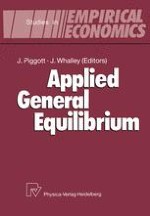1991 | OriginalPaper | Buchkapitel
Industrial Organization Implications of QR Trade Regimes: Evidence and Welfare Costs
verfasst von : Timothy Condon, J. de Melo
Erschienen in: Applied General Equilibrium
Verlag: Physica-Verlag HD
Enthalten in: Professional Book Archive
Aktivieren Sie unsere intelligente Suche, um passende Fachinhalte oder Patente zu finden.
Wählen Sie Textabschnitte aus um mit Künstlicher Intelligenz passenden Patente zu finden. powered by
Markieren Sie Textabschnitte, um KI-gestützt weitere passende Inhalte zu finden. powered by
Evidence of the relationship between trade regimes, concentration and profitability in semi-industrial countries’ manufacturing sectors is reviewed. This evidence is used to justify the formulation and simulation of a three sector general equilibrium model in which the manufacturing sector’s behavior is linked to the degree of restrictiveness of the QR regime. Simulations are conducted with several variants of the model to ascertain separately the effects of introducing economies of scale, firm entry/exit, departures from competitive pricing, and interactions between entry and pricing rules. Numerical results suggest that a 20 percent rationing rate of intermediates and consumption goods can have welfare costs of about 2.0 percent of national income in the absence of economies of scale and industrial organization interactions with the trade regime. When industrial organization features are included, the costs of the same 20 percent rationing quadruples.
